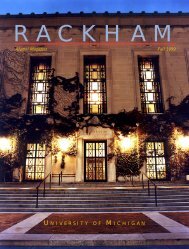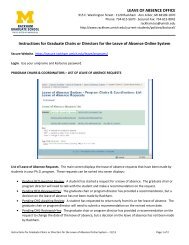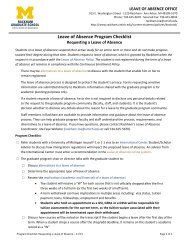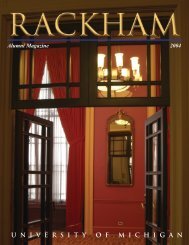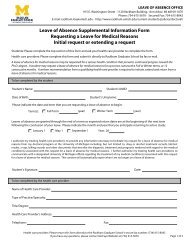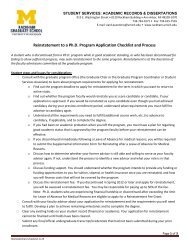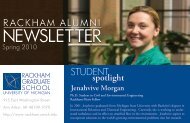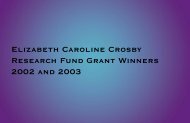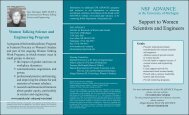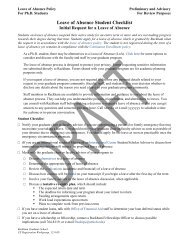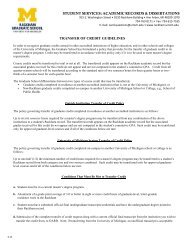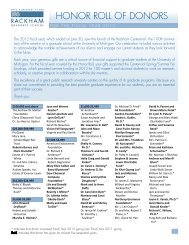Alumni Magazine 2001-2002 UNIVERSITYOFMICHIGAN - Rackham ...
Alumni Magazine 2001-2002 UNIVERSITYOFMICHIGAN - Rackham ...
Alumni Magazine 2001-2002 UNIVERSITYOFMICHIGAN - Rackham ...
You also want an ePaper? Increase the reach of your titles
YUMPU automatically turns print PDFs into web optimized ePapers that Google loves.
Photo by Sheila Ryan<br />
One of Milton Morris’ most<br />
memorable moments as a<br />
member of Northwestern<br />
University’s football team came<br />
against the University of Michigan, a<br />
33-yard pass reception when he was a<br />
freshman in 1988. In 1992, Michigan<br />
caught Morris — he earned his master’s<br />
and PhD in electrical engineering<br />
from U-M — and then Guidant<br />
Corporation of St. Paul, Minnesota,<br />
did the same. Fewer than four years<br />
after joining that company, one of the<br />
world’s leading makers of cardiac<br />
devices, Morris became its manager<br />
of tachycardia therapy research, in<br />
charge of designing and testing products<br />
that will add many moments to<br />
many lives.<br />
Where he’s at right now offers him<br />
the best of several worlds. He still<br />
does research, publishes articles and<br />
presents at professional conferences,<br />
although his research is usually, and<br />
understandably, targeted toward specific<br />
applications. He also returns to<br />
Ann Arbor periodically, both to recruit<br />
doctoral students for Guidant and as a<br />
member of the <strong>Rackham</strong> Dean’s<br />
Advisory Board, and he teaches courses<br />
at the University of Minnesota.<br />
Algorithms<br />
for Better Living<br />
“It’s not necessarily about saving<br />
lives but certainly improving<br />
the quality of life.”<br />
Multiple worlds are nothing new to<br />
Morris, although he says excelling<br />
both academically and athletically is<br />
not as rare as the conventional wisdom<br />
would have it. This is based not<br />
only on his own playing career, but<br />
also on the three years he spent tutoring<br />
athletes while he was in graduate<br />
school, the last two focused on football<br />
players.<br />
“The college athlete probably gets a<br />
bum rap,” he says. “There are a lot of<br />
really bright guys on the football team<br />
and I’m not sure people are aware of<br />
that or care to acknowledge it. I am<br />
still familiar with the pain and struggle<br />
associated with undergraduate<br />
football and engineering.”<br />
The loop he’s in now has been dominated<br />
by spearheading improvements<br />
to the implantable cardioverter defibrillator<br />
(ICD), the most recent addition<br />
to Vice President Cheney’s internal<br />
hardware. “Guidant is a major<br />
manufacturer of that device, although<br />
his comes from the competition,” says<br />
Morris, “but he does have one of our<br />
stents!”<br />
The ICD addresses irregularities in<br />
the heartbeat that can render victims<br />
fatigued and dizzy. “It’s not necessarily<br />
about saving lives but certainly<br />
improving the quality of life,” he says.<br />
“A major thrust of what I’ve been<br />
doing here for the last three years or<br />
so is designing the algorithms that<br />
allow the device to detect an atrial<br />
arrhythmia from a ventricular arrhythmia<br />
and also to evaluate the actual<br />
therapies and the diagnostics that this<br />
device would provide. I actually came<br />
up with some of the algorithms, tested<br />
those algorithms and transferred them<br />
over to the design teams, set up some<br />
clinical studies in Europe and Asia to<br />
look at therapies for atrial fibrillation,<br />
and did a whole host of other miscellaneous<br />
things to help the design<br />
teams alter their device.”<br />
Morris never dreamed of a career in<br />
medical science when he started graduate<br />
school as a signal processing<br />
major, but it just happened that the<br />
signal he was processing was a biological<br />
one. “That required me to<br />
learn about biophysics, physiology<br />
and in particular cardiac electrophysiology,”<br />
he recalls. “I found the material<br />
that I was being taught really compelling<br />
and very interesting. It struck<br />
a chord with me and I haven’t looked<br />
back since.” ■ 7<br />
A L U M N I P R O F I L E S



